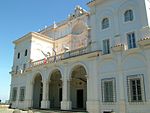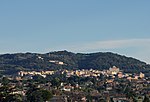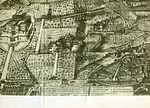Church of the Gesù, Frascati

Church of the Gesù is a Roman Catholic church in Frascati, in the province of Rome, in Italy. The original church was built in 1520. In 1554, the city began the construction of the another church to replace the original church., but did not complete it. In 1560, the Jesuits took possession of the site and completed it by 1597, calling it the church of the Annunciation of the Blessed Mary. In 1694 the Jesuits decided to expand the church and completed the new church by 1700. The 18th century Blessed Antonio Baldinucci developed a particular devotion to the Refugium Peccatorum (Refuge of Sinners) image of Virgin Mary in the church, which has been considered miraculous. The Jesuits spread copies of the image to Mexico by the 19th century and it began to be depicted in missions there.Saint Vincent Mary Pallotti celebrated his first Mass here.
Excerpt from the Wikipedia article Church of the Gesù, Frascati (License: CC BY-SA 3.0, Authors, Images).Church of the Gesù, Frascati
Via Remigio Farnetti,
Geographical coordinates (GPS) Address External links Nearby Places Show on map
Geographical coordinates (GPS)
| Latitude | Longitude |
|---|---|
| N 41.808611111111 ° | E 12.681111111111 ° |
Address
Chiesa del Gesù
Via Remigio Farnetti
00044
Lazio, Italy
Open on Google Maps









